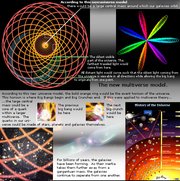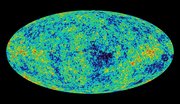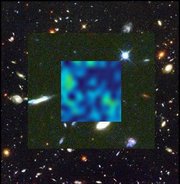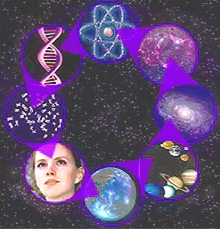K. Marinas' Cyclic Multiverse Hypothesis
From Academic Publishing Wiki
I, K. Marinas, am the founder of my Cyclic Multiverse Hypothesis¹, in which I propose that universe is a fractal, as an alternative to the Big Bang Theory. My idea is not science as of yet, since the vast majority of detailed cosmological data and computing power is outside of my reach. Another reason why it is not science right now is because it is not being studied by staff of a university. This page is not something you can nor should cite for a school project. Meanwhile, I think that my idea lacks the errors of previous alternatives to the Big Bang Theory.
Contents[hide] |
Visual aid depicting a fractal universe
What this hypothesis requires
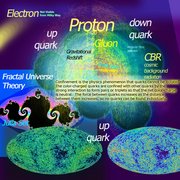
TeraQuasars
New kinds of collapsed masses called TeraQuasars. These are proposed celestial objects with the proposed mass of trillions of quasars located behind the furthest galaxies and stars we can see in the universe - see Hubble Deep Field.
- Gravitational redshift is the decrease of a photon's frequency with increasing gravitational potential. This kind of redshift is directly linked with the curvature of the gravitational field.
- Angular diameter distance of distant galaxies can be explained as being an effect caused by the massive gravitational lensing of TeraQuasars.
Concordance with WMAP
To explain the Cosmic Background Radiation, the Cyclic Multiverse Hypothesis requires that TeraQuasars are surrounded by an environment which has a similar (if not exactly the same) composition as the one described in the Big Bang theory of the "early" universe. This analogous to quasars in the centers of galaxies which have a radiation intense environment surrounding them. This enviornment would be a shell surface that today's cosmologists call the surface of last scattering. However, in contrast to the idea of todays cosmologists - that the surface of the last scattering is a spherical shell concentric to the point of observation - in this Cyclic Multiverse Hypothesis, the surface of the last scattering occurs at ellipsoid-like surfaces of several TeraQuasars - at the same temperature (~3000K) and redshift (~1100).Contrast from Black Holes
Contrast from Cyclic Big Bang/Big Crunch
Instead of an inflating singularity that collapses upon itself and reinflates etc., the Cyclical Multiverse Hypothesis proposes that the TeraQuasars are the source of new matter (predominately hydrogen) and that old and new matter can enter and exit the multimillion-light-year thick atmosphere of TeraQuasars. A fractal a with pattern that repeats towards the infinitely large scales and towards the infinitely small scales is necessarily heterogeneous in space at all levels, whereas many cyclic universe models based on the Big Bang Theory suggest that the universe is homogeneous and isotropic at large scales.
More on the size of TeraQuasars
Since TeraQuasars would be very large and exist behind a significant fraction of the sky, even more than the Andromeda Galaxy which itself spans 8 moon diameters, they would appear basically uniform and isotropic when viewed through the microwave spectrum. The TeraQuasars could also be accompanied by smaller partners, or GigaQuasars, which would be like TeraQuasars, but many times smaller.Hyperbolic Space-Time
Hyperbolic space-time is an idea from General Relativity - see Hyperbolic geometry and General Relativity.
- Observations of galactic rotation velocities (see Galaxy rotation problem) and the brightness of distant supernovas (see Dark Energy) cause the author to suggest that the space outside our solarsystem, between the stars and between the galaxies is hyperbolic.
- Consequences of Hyperbolic Geometry:
- Stars and galaxies would be dimmed by a factor different than the inverse-square law.
- The low-density space between the stars and between the galaxies would act like a concave (zoom out) lens. The parallaxes of stars would be smaller than it would be without the Hyperbolic curvature of space-time, which means that stars and galaxies would be closer than what would be believed if the space between stars was Euclidean. The galaxy would be smaller in diameter than it appears, however, the star count would remain valid. The arms of the Milky Way galaxy would be "lubricated" since the stars would have tendency to repel one another, like protons in a nucleus. Stars would flow faster than they would otherwise. Despite this, the collective gravity of galaxies would keep stars inside a spiral disk, ellipsoid, or irregular shape. That means that the hyperbolic space between the stars is encapsulated by the greater gravity of the whole.
- Having negative curvature between galaxies in clusters would make them appear farther apart than they really are. The required dark matter abundance would be reduced significantly.
- The observable part of our universe would be smaller than it appears, yet remains stable due to local gravitational repulsion within the gravity of the whole.
The Pioneer Anomaly as a possible determinant
The
Pioneer Anomaly is an anomalous acceleration of the Pioneer
10 & 11 probes towards the sun. The Pioneer Acceleration
 is approximately
is approximately
 .
The Hubble Constant
.
The Hubble Constant
 is approximately
is approximately
 which is equal to
which is equal to
 .
The Hubble Acceleration
.
The Hubble Acceleration
 is equal to the Hubble Constant
is equal to the Hubble Constant
 times the speed of light
times the speed of light
 which is equal to
which is equal to
 .
From the proximity of the Pioneer Acceleration
.
From the proximity of the Pioneer Acceleration
 and the Hubble Acceleration
and the Hubble Acceleration
 ,
we may induce that these accelerations have a common cause.
,
we may induce that these accelerations have a common cause.
Some insight on this acceleration can be derived from an
alternative to the Newtonian approximation of
gravitational potential. In this article,
gravitational potential refers to
gravitational potential energy divided mass
 .
.
1) Given that the integral of acceleration
 with respect to radius
with respect to radius
 equals the gravitational potential, derive formula the
gravitational potential
equals the gravitational potential, derive formula the
gravitational potential
 .
.
Elliptic Geometry exists where
 .
.
Euclidean Geometry exists where
 .
.
Hyperbolic Geometry exists where
 .
.
The beginning of this Fractal-based Unification of the Gravitational, Weak, Electromagnetic, and Strong forces
In the Cyclical Multiverse Hypothesis, the gravitational attraction of our fractal level becomes a binding force in the higher fractal level that:
- opposes a nucleus' tendency to split apart (The Strong Nuclear Force)
- becomes the attractive force between protons and electrons (The Attractive Electromagentic Force)
Similiarly, the gravitational repulsion defined by the mechanism above becomes a seperating force in the higher fractal level that:
- decays massive particles (such as neutrons) into smaller ones (The Weak Force)
- leads to CP-violation in antimatter (The Weak Force)
- keeps the nucleus from becoming a black hole (The Repulsive Electromagentic Force)
- prevents the electron from merging with a proton (depsite their opposite charge)
- puts a limit on the number of electrons an element can have
If the universe were eternal, the weak force would have enough time to accumulate the observed difference between the amount of matter and antimatter. The remaining antimatter would be maintained by natural particle accelerators found inside extreme environments such as the center of the Milky Way.
These become the two fundamental forces (i.e. the binding force and the seperating force) of the universe. Both must exist in order for the fractal universe to be eternal and moderate.
A Fractal Universe and Physical Units
The Cyclic Multiverse is a self-similiar fractal which might have formed just like a snowflake would. Anything from the curvature of spacetime to the pattern of a snowflake can ultimately explained with units of measurement.
The multiple between fractal levels
 is equal to the ratio of the
color force to the
gravitational force.
is equal to the ratio of the
color force to the
gravitational force.
The changes of primary physical properties for the lower fractal level are as follows²:

| frequency | Hertz | 1/s |

| temperature | Kelvin | K |
| velocity | Meters per second | m/s |

| wavelength (distance) | Meters | m |
| luminous intensity | Candelas | Cd |

| charge | Columbs | C |
| mass | Kilograms | kg |
From these assumptions, we can determine the changes that occur in other physical properties for every fractal level we go down.
The changes of physical properties for the lower fractal level are as follows:
Gravitational Phenomena

| angular velocity | radians/s |
| density | kg/m3 |
| force/mass | m/s2 |
| G | m3/(kg·s2) |
| pressure | N/m2 |
Electromagnetic Phenomena
| spectroscopic wavenumber | 1/m | the inverse of wavelength |
| frequency | 1/s | influences the other electrical properties for this lower fractal level (Hz, cycles per second) |
| angular frequency | radians/s | frequency with which phase changes |
| electric field strength | N/C | force / charge |
| current density | A/m2 | current / area |
| light flux density | lm/m2 | light incident / area |
| luminosity | Cd/m2 | light emission / area |
| magnetic flux density | Wb/m2 | magnetic flux / area |
| permeability | N/A2 | allows an electric field to pass through easily, lets charge through |
| resistance | W/A2 | higher electrical resistance at the lower fractal level (ohms Ω) |
| charge density | C/m3 | charge / volume |
| energy density | J/m3 | energy / volume |

| applied tension | J/m2=N/m | work / area |
| inductance | J/A2 | accomodation of the production of magnetic flux per current |
| reluctance | A2/J | resistance of the production of magnetic flux per current |
| potential difference | W/A=J/C | power per unit current. energy per unit charge. current times resistance. (volt) |
| luminous efficacy | lm/W | power as it appears to an observer versus the actual power |
| conductivity | 1/(Ω·m) | property of matter which allows an electric field to get from A to B |
| resistivity | Ω·m | property of matter which resists an electric field from getting from A to B |

| wavelength (distance) | m | influences the other electrical properties for this lower fractal level |
| current | A | flow rate of electricity which provides a force that causes magnetic flux |
| luminous intensity | Cd | power emmited by a light source |
| luminous flux | lm=Cd·sr | Candelas times Steradians (lumens, lm) |
| magnetic flux | Wb=J/A=V·s | comes from an energetic magnetic field produced by a current (weber, Wb) |
| power | W=J/s | rate of energy expenditure |
| force | N=J/m | comes from a energetic kinetic potential produced by an impulse |
| conductance | A/V | current produced / (energy / charged particle) |
| permittivity | C/(V·m) | resists the flow of an electric field, contains charge |

| heat capacity | J/K | proportion relating the amount of energy per temperature |
| capacitance | F=C2/J | quantity of charge stored for every volt (farads) |
| coulombs | A·s | quantity of electric charge itself |
| energy | J=kg·m2/s2 | quantity of energy itself |
| mass | kg | equivalence of mass and energy. where there is point mass, within it are point charges. |
| perception of light | lm·s | living things on the lower fractal level see photons which are 10^80 times smaller. |

| electric dipole moment | A·s·m | a vector due to uneven distribution of unlike charges. proportional to charge and distance. |
| planck's constant | J·s | the discrete quantity of action (quantum unit of angular momentum) |
| magnetic dipole moment | A·m2 | a vector whose direction is normal to a loop of current. proportional to current and area. |
Temperature Phenomena

| thermal heat transfer coefficient | (W/m2)/K | coefficient, thermal conductance |
| thermal resistance | K/W | index of a material's resistance to heat flow
the reciprocal of conductance |

| temperature | K | corresponding objects of the lower fractal are just as hot, or as cold, as they are in our fractal level |
| thermal conductivity | (W/m)/K | ability of a material to conduct heat. |
| thermal expansion coefficient and temperature of color | 1/K | the fractional change in length or volume per Kelvin at constant pressure |
| velocity change with temperature | (m/s)/K | velocity increases with temperature |
| thermal heat capacity | J/kg | the heat required to raise the temperature of a substance. |

| thermal conductance | W/K | rate of heat flow |
| thermal resistance coefficient | K/(W/m2) | coefficient, thermal resistance |
Material Phenomena
| acoustic impedance | (kg/s)/m2 | proportional to the density and the phase velocity (speed of sound). |

| dynamic viscosity | (kg/s)/m | the resistance of a fluid to deformation under shear stress |
| surface tension | J/m2 | the amount of tension that keeps a surface, especially of liquids together |

| mass flow rate | kg/s | the mass of fluid that flows past a given cross sectional area per second |
| kinematic viscosity | m2/s | ratio of dynamic viscosity to mass density |
Correlations with substance

| angular acceleration | radians/s2 | rate of change of angular velocity |

| area | m2 | such as the area of a crossection of a specified part of a vacuum which lets photons of the lower fractal level through. Photons/area is a constant for corresponding areas of different fractal levels |
| impulse and momentum | N·s=kg·m/s | force * time. mass * velocity. |
| volume flow rate | m3/s | the volume of fluid that flows past a given cross sectional area per second |
| torque | kg·m2/s2 | force applied to a member to produce rotational motion |
Planck units

| planck temperature | K | 1.41679E+32 K |

| planck length | m | 1.61624E-76 m |
| planck time | s | 5.39121E-85 s |

| planck charge | C | 1.8755459E-100 C |
| planck mass | kg | 2.17645E-90 kg |
Symmetry inside the fractal
| Proton & Electron:
Electromagnetic effects dominate causing simple periodic motion. |
Natural, Biological,
and Artificial Machines:
Electromagnetism can power objects inside a large Gravitational field. Balance of Gravity and Electromagnetism creates very complex forms. |
| Quarks:
Strong Interaction can power objects inside a large electric field. Balance of Electromagnetism (Electric Charge) and Strong Interaction (Quantum Gravity) creates complex forms. |
Stars & Planets:
Gravitational effects dominate causing very simple periodic motion. |
7 rotational degrees of freedom
| level | name | attribute |
| 7 | .... | .... |
| 1 | Electrons | more divergence |
| 2 | Molecules | electromagnetic bonding |
| 3 | Bodies | birth from electromagnetism |
| 4 | Stars | birth from gravity, death from electromagnetism |
| 5 | Star clusters | birth from gravity |
| 6 | Galaxies | gravitational bonding |
| 7 | TeraQuasars/Quarks | more convergence |
| 1 | .... | .... |
Testing Claims of this Cyclic Multiverse Hypothesis
A section of this Cyclical Multiverse Hypothesis predicts an
anomalous acceleration towards the sun
 at distances up to, but not including
at distances up to, but not including
 which is about 390 billion kilometers - beyond that, an
acceleration of the same magnitude, but in the opposite
direction is expected, that is to say, even without propulsion.
In this theory, the formula for orbital velocity
which is about 390 billion kilometers - beyond that, an
acceleration of the same magnitude, but in the opposite
direction is expected, that is to say, even without propulsion.
In this theory, the formula for orbital velocity
 would be adjusted to:
would be adjusted to:
Escape velocity
 would be adjusted to:
would be adjusted to:
Where
 the
gravitational potential which is the same as
gravitational potential energy divided by mass. This value
is equal to the
integral of
the
gravitational potential which is the same as
gravitational potential energy divided by mass. This value
is equal to the
integral of
 with respect to radius
with respect to radius
 .
.
This entails that the orbit of 90377 Sedna would be constricted at much greater distances from the sun than its current position. Hundreds of years into the future at the farther ends of its orbit, it would fail to match the orbital trajectory predicted by Newton's theory.
Beyond a distance of
 ,
gravitational potential with repsect to mass
,
gravitational potential with repsect to mass
 becomes positive, and the result would be a gravitational
repulsion relative to mass
becomes positive, and the result would be a gravitational
repulsion relative to mass
 .
.
References
Particles, Subatomic. (1976) The New Encyclopedia Britannica (15th ed.) Vol 13. p 1026.
(2005) Wikipedia: The Free Encylopedia
http://www.space.com/scienceastronomy/astronomy/gravastars_020423.html
Footnotes
¹ This hypothesis was formerly called Cyclical or Cyclic Multiverse Theory. K. Marinas later renamed it because the specific meaning of the word "theory" has a literal interpretation in the sciences which is different than the literal interpretation of the layman.
² Originally, I tried defining the mass in proportion to the
distance (i.e. 1E-41 when distance was 1E-41), while using the
Schwarzschild radius
 as a guideline for how I should start investigating, but then
after considering the mass of the universe in relation to a
proton, I realized that it would not work that way. I dismissed
that a couple times, since that would require redefining the
Gravitational Constant for the lower fractal level which is
described in units of
as a guideline for how I should start investigating, but then
after considering the mass of the universe in relation to a
proton, I realized that it would not work that way. I dismissed
that a couple times, since that would require redefining the
Gravitational Constant for the lower fractal level which is
described in units of
 .
.
